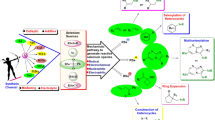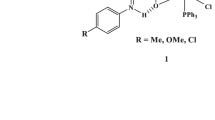Conclusions
-
1.
The protolysis of phenylmercury bromide by hydrogen chloride in aqueous dioxane in the presence of sodium iodide is accomplished according to different mechanisms, depending upon the water content in the solvent.
-
2.
In 90–95% dioxane, protolysis proceeds according to an SE2 mechanism, through a closed transition state.
-
3.
In 80–60% dioxane, protolysis proceeds according to an SE1 mechanism, complicated by acid catalysis, accomplished by ion pairs of the acid.
-
4.
An approximate calculation of the kinetics in the transition region (85% dioxane) was undertaken.
Similar content being viewed by others
Literature cited
I. P. Beletskaya, A. E. Myshkin, and O. A. Reutov, Izv. AN SSSR, Ser. Khim.,1965, 240.
O. A. Reutov, B. Praisnar, I. P. Beletskaya, and V. I. Sokolov, Izv. AN SSSR, Otd. Khim., N.,1963, 970.
I. P. Beletskaya, V. I. Karpov, and O. A. Reutov, Izv. AN SSSR, Ser. Khim.,1966, 963.
A. N. Nesmeyanov, L. G. Makarova, and T. P. Tolstaya,1, 145 (1957).
E. A. Braude, J. Chem. Soc.,1944, 443.
O. A. Reutov, I. P. Beletskaya, and M. I. Aleinikova, Zh. Fiz. Khimii,26, 489 (1962).
K. Ichikava, H. Ouchi, and S. Araki, J, Amer. Chem. Soc.,82, 3880 (1960).
F. Kaufman and A. H. Corwin, J. Amer. Chem. Soc.,77, 6280 (1955).
R. E. Dessy, G. F. Reynolds, and Kim Sin-young, J. Amer. Chem. Soc.,81, 2683 (1959).
O. W. Berg, W. P. Lay, A. Rodgam, and G. F. Wright, Canad. J. Chem.,36, 358 (1958).
H. S. Harned et al., J. Amer. Chem. Soc.,60, 336, 339, 2128, 2130, 2133 (1938).
E. A. Braude and E. S. Stern, J. Chem. Soc.,1948, 1976.
J. J. Delpuech, Compt. rend.,256, 934 (1963).
M. M. Kreevoy, J. Amer. Chem. Soc.,79, 5927 (1957).
S. Winstein, E. Clippinger, A. M. Fainberg, and G. C. Robinson, J. Amer. Chem. Soc.,76, 2597 (1954).
E. D. Hughes, C. K. Ingold, and U. G. Shapiro, J. Chem. Soc.,1936, 225.
G. Barbieri and A. Pignedoli, Atti Soc. natur. e mat. Modena,85–86, 95, 1954–1955 (1956).
V. Gold, J. Chem. Soc.,1956, 4633.
P. Casapieri and E. P. Swart, J. Chem. Soc.,1961, 4342.
I. B. Xyne and P. E. Robertson, Canad. J. Chem.,34, 863 (1956).
C. Prevost, Ind. chim. belge,23, 1231 (1958).
Author information
Authors and Affiliations
Additional information
Translated from Izvestiya Akademii Nauk SSSR, Seriya Khimicheskaya, No. 2, pp. 238–245, February, 1967.
Rights and permissions
About this article
Cite this article
Beletskaya, I.P., Myshkin, A.E. & Reutov, O.A. Electrophilic substitution of the aromatic carbon atom. Russ Chem Bull 16, 232–238 (1967). https://doi.org/10.1007/BF00912419
Received:
Issue Date:
DOI: https://doi.org/10.1007/BF00912419




